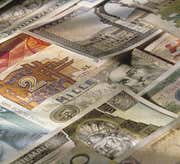
|
The price-to-earnings ratio, or P/E is the ratio of the market price of a company’s stock to its earnings per share (EPS):
| P/E Ratio = | Market Value per Share |
| Earnings per Share (EPS) |
Many times, investors look to the past four quarters of earnings and calculate annual earnings per share. This is known as the trailing P/E.
If a company’s shares are trading at $20 and it’s earnings per share was $1.25 over the past year, the trailing P/E would be 16x. The P/E is often expressed a multiple of earnings. Notice that the P/E ratio is not expressed in dollar terms – this is because the dollar terms in the numerator and denominator of the P/E ratio formula cancel each other out. This leaves us with an apples to apples comparison with other companies' P/Es. If a second company in the same industry was trading with a P/E of 10x, an analyst would have to determine if one was overpriced relative to the other.
Sometimes, analysts are interested in long term valuation trends and consider the P/E 10 or P/E 30 measures, which average the past 10 or past 30 years of earnings, respectively. These measures are often used when trying to gauge the overall value of a stock index, such as the S&P 500 since these longer term measures can compensate for changes in the business cycle. The P/E ratio of the S&P 500 has fluctuated from a low of around 6x (in 1949) to over 120x (in 2009). The long-term average P/E for the S&P 500 is around 15x, meaning that the stocks that make up the index collectively command a premium 15 times greater than their weighted average earnings.
The trailing P/E ratio will change as the price of a company’s stock moves, since earnings are only released each quarter while stocks trade day in and day out. As a result, some investors prefer the “forward” or leading P/E. The forward P/E ratio is similar to the trailing, but uses estimates of projected future earnings, typically forecast over the next twelve months. If the forward P/E ratio is lower than the trailing P/E ratio, it means analysts are expecting earnings to increase; if the forward P/E is higher than the current P/E ratio, analysts expect a decrease in earnings.
Companies that aren't profitable, and consequently have no earnings – or negative earnings per share, pose a challenge when it comes to calculating their P/E. Opinions vary on how to deal with this. Some say there is a negative P/E, others assign a P/E of 0, while most just say the P/E doesn't exist or is not interpretable until a company becomes profitable for purposes of comparison.
A variation on the forward P/E ratio is the price-to-earnings-to-growth ratio, or PEG. The PEG ratio is calculated as a company’s trailing price-to-earnings (P/E) ratio divided by the growth rate of its earnings for a specified time period. The PEG ratio is used to determine a stock's value based on trailing earnings while also taking the company's future earnings growth into account, and is considered to provide a more complete picture than the P/E ratio. For example, a low P/E ratio may suggest that a stock is undervalued and therefore should be bought – but factoring in the company's growth rate to get its PEG ratio can tell a different story. PEG ratios can be termed “trailing” if using historic growth rates or “forward” if using projected growth rates.
P/E Ratio: Using The P/E Ratio
-
 Investing
InvestingComparing the P/E, EPS And Earnings Yield
Here are three ratios that help investors value stock returns. -
 Investing
InvestingCan Investors Trust The P/E Ratio?
The P/E ratio is one of the most popular stock market ratios, but it has some serious flaws that investors should know about. -
 Investing
InvestingAre stocks with low P/E ratios always better?
Is a stock with a lower P/E ratio always a better investment than a stock with a higher one? The short answer is no. The long answer is it depends. -
 Investing
InvestingUnderstanding The P/E Ratio
Learn what the price/earnings ratio really means and how you should use it to value companies. -
 Investing
Investing8 Blue Chip Stocks with Low P/E Ratios
Discover why the price/earnings (P/E) ratio is important in determining the relative value of a stock and find out which S&P 500 stocks have the lowest P/E ratios. -
 Investing
InvestingThe average price-to-earnings ratio in the retail sector
Find out about the retail sector's average price-to-earnings ratio, or P/E ratio, and average P/E for companies in the seven different categories of retail.


